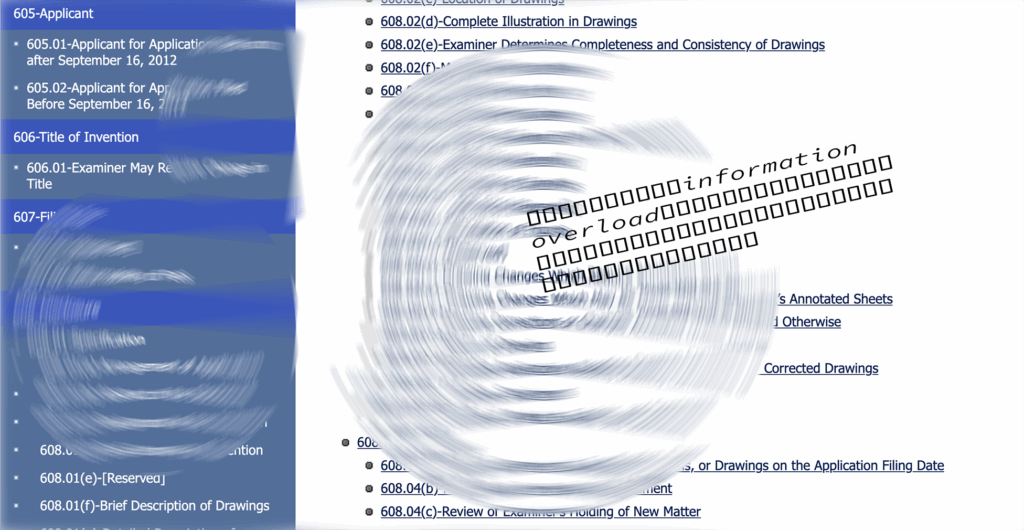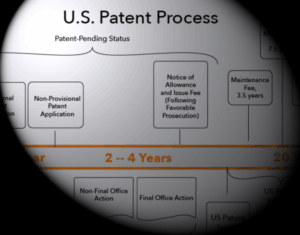
Filing a patent application: all the steps you need to know.
1. Do a Prior-Art Search.
To determine whether your invention already exists and to gauge the “state of the art,” we do a prior-art search. It’s optional, but we strongly advise it. Here’s why.
2. File a Provisional Patent Application.
A provisional patent application is the quickest and least-expensive starting point. It gives an inventor one year to research, develop, and fine-tune an invention before making official claims.
Filing a provisional gives inventors a “priority date,” i.e., a U.S. filing date that holds their place for one year, until they file a nonprovisional application. Once the provisional application is filed, an inventor may claim patent-pending status. Provisional applications are not examined by the USPTO. An inventor with a fully developed invention may choose to skip this step and go straight to nonprovisional filing (below).
3. File the nonprovisional application.
Within one year of filing a provisional application, inventors file a Non-Provisional Patent Application. This is the application in which an inventor makes their formal claims. Once filed, it goes through the rigorous examination process at the USPTO.
4. File an Information Disclosure Statement.
An IDS is a statement in which an inventor discloses information that is material to patentability. The Patent Office describes this as a “duty of disclosure.” It involves submitting a form within three months of your nonprovisional filing date, or any time before the first office action. An IDS can help safeguard a granted patent against infringement litigation.
5. Wait.
Initial examination of a nonprovisional patent application can take up to 20 months. During this time an invention has patent-pending status. For good reason, many inventors prefer patent-pending status over patented status. (Stay tuned for a blog post on this.)
The time between filing and grant is called prosecution.
6. If needed, file a CIP.
In the event of a substantial change to an existing nonprovisional patent application, an inventor may opt to file a Continuation-in-Part (CIP) any time during pendency. A CIP has a parent-child relationship with the originally filed nonprovisional application. (Stay tuned for a blog post on this).
7. Gird your loins.
The first communication from the patent examiner comes in the form of an Office Action. These represent the patent examiner’s formal examination of your application. They may list prior art and rationales for allowed (approved) claims or rejected claims.
Don’t be discouraged when you see an examiner’s rejections. It often takes a few tries to overcome prior art that the examiner has identified. Sometimes an application is immediately granted, but this is not optimal; it could indicate that the invention’s claims were too narrow, and you’ve left something on the table. A good patent practitioner knows how to walk this line carefully. They write your application to be as realistically broad as possible within the boundaries of your invention, in light of the prior art.
At any of these stages, an inventor may be eligible to fast-track prosecution. That’s outlined on the USPTO’s Patent Application Initiatives Timeline.
The next-to-last step in patent prosecution is, optimally, the Notice of Allowance. Here is where we congratulate ourselves on our hard work; pay an Issue Fee; and wait for notification of our patent number.
Once issued, a typical U.S. patent is in force for 20 years from file date. This date is fungible when there are Continuations involved, but this is generally not the practice of independent inventors.
Total Estimated Years of Your Life: 2 — 4
Once a patent is granted, inventors must pay Maintenance Fees every few years. Please see our post on that.
USPTO Fees vary by type of patent application, and by number of claims made. Basic fees for utility patents:
– A non-refundable filing fee
– Professional fees charged by a patent practitioner (that’s us) during prosecution.
– An issue fee (paid only when an application is allowed)
– Maintenance fees (paid at 3 1/2, 7 1/2, and 11 1/2 years after your patent is granted – these fees “maintain” your legal protection)
Check the USPTO’s current fee schedule before submitting an application.
All of this has been distilled into a patent-process infographic, thumbnailed below. For a full-size copy, please contact us and we will send you one.
More information can be found at the USPTO’s Patent Process Overview page.
Questions? Contact us. We a team of humans who answer the phone.

This content was written by a human named Regina DeAngelo. It is not legal advice. When quoting, please cite KeeleyDeangelo.com/blog. Copyright 2025, KeeleyDeAngelo.com.
